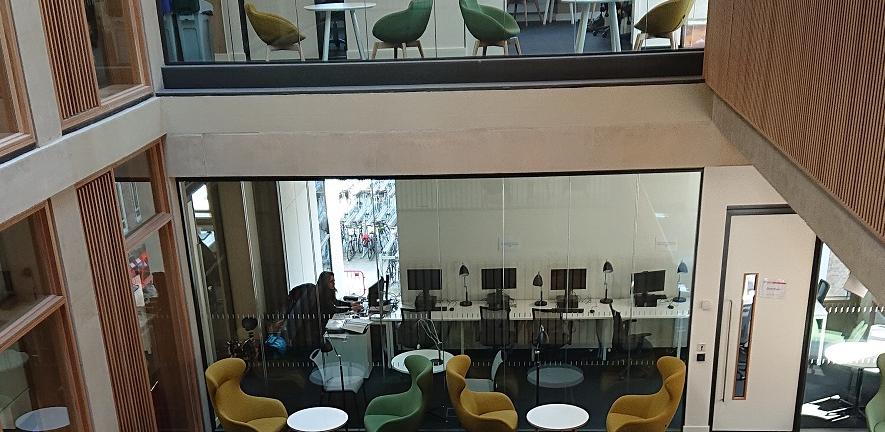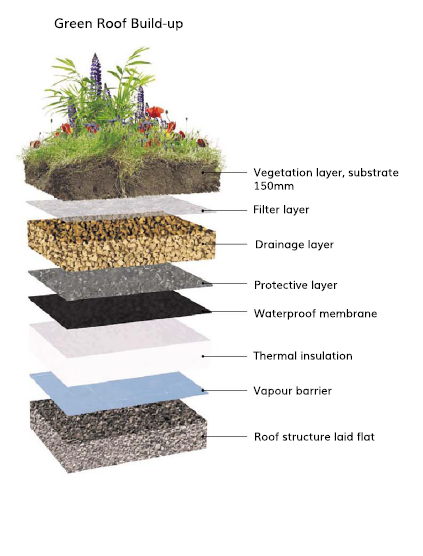
Submitted by Grainne Kennedy on Tue, 2019-04-23 15:03
The new Student Services Centre has made history, for the first time all student services in the University have been brought under the one roof. The building itself incorporates the best of old and new as the Arts School has been renovated with new efficient fixtures and fittings, while the new wing has exciting installations such as the wildflower meadow on the roof. Sustainability has been a key consideration in the design of the building and impacts so much of how the building operates.
Heating and cooling
New efficient gas boilers supply heat to the building’s radiators. Spaces are naturally ventilated where possible. In the New Wing many of the rooms are provided with high level automatic vents that will open if internal temperatures go above twenty two degrees Celsius or if carbon dioxide concentrations exceed 1000 parts per million.
In summer operation the building has been designed to avoid mechanical cooling where possible. This saves energy and minimises reliance on refrigerants. Refrigerants can have a very high global warming impact if they escape, for this reason we avoid using and installing air conditioning where possible.
To keep the building comfortable, concrete surfaces have been left exposed to soak up heat. In hot weather the automatic vents in the New Wing will open at night to flush the concrete with cool air so the concrete acts as a natural store of ‘coolth’.
In the older parts of the building heavy masonry walls and high ceilings also help slow the rate of heat build-up.
Lighting
In most spaces motion sensors are used to turn the lights on, they will dim or turn off if no movement has been detected for some time. Software allows the length of time delay, light intensity and detector sensitivity to be adjusted if necessary.
For energy efficiency many of the lights that are close to windows are linked to daylight sensors and will automatically dim down when there is sufficient daylight.
Solar Power
The New Wing has an array of photovoltaic solar panels on the roof. You can watch a time-lapse video of their installation here. The estimated annual generation of these panels is 31,815kWh.
Green roof
The new roof also includes an area of habitat designed to promote insect life (figure 1) that will encourage birds and bats to visit the site. It includes:
- An area of thin soil is covered with clay roof tiles reclaimed from the old Arts School. This is sown with a wildflower and meadow grass mix and will be largely left to its own devices.
- A thicker area of soil is planted with yarrow, maiden pink, autumn crocus, bowden lily, sedum, thyme, primrose, sempervivum and a variety of grasses.
- Untreated native hardwood logs with ends drilled to provide nesting holes for solitary bees.
- Small ephemeral pools lined with pebbles to provide places for birds to drink and bathe.

Figure 1: Green roof design at the Student Services Centre
Travel
In addition to surface level parking there will be cycle parking in the basement of the old Arts School Building. This area will also include lockers for folding bicycles and clothing lockers. The basement also contains showers for staff. In the coming months Student Services Centre staff will also have access to pool bikes on the New Museum Site.
Green Impact team
Staff at the Student Services Centre have already started to recruit members for a building Green Impact team. Some of the sections within the building, such as the Counselling Service and Cambridge Commonwealth and European International Trust, are already experienced in making sustainable change through Green Impact. A new Green Impact team will provide an opportunity for staff from different sections to come together to make sustainable actions easy for all. We look forward to seeing what they will do.
If you are a member of staff in the Student Services Centre, please download this guide explaining building controls. Or if you are interested in joining the building Green Impact team speak to the Reception Team.
